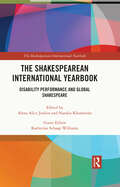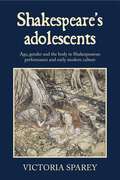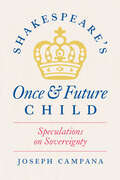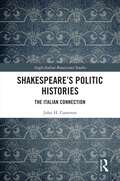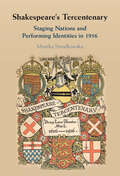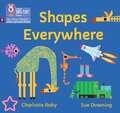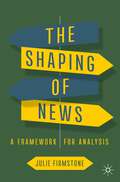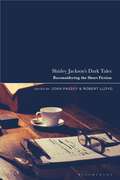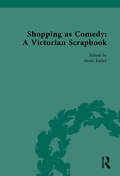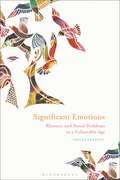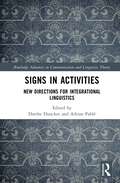- Table View
- List View
The Shakespearean International Yearbook: Disability Performance and Global Shakespeare (The Shakespearean International Yearbook)
by Alexa Alice Joubin Natalia Khomenko Katherine Schaap WilliamsThe Shakespearean International Yearbook surveys the present state of Shakespeare studies in global contexts, addressing issues that are fundamental to our interpretive encounter with Shakespeare’s work and his time. Contributions are solicited from scholars across the field and from both hemispheres of the globe who represent diverse career stages and linguistic traditions. Both new and ongoing trends are examined in comparative contexts, and emerging voices in different cultural contexts are featured alongside established scholarship. Each volume features a collection of articles that focus on a theme curated by a specialist Guest Editor, along with coverage of the current state of the field in other aspects. An essential reference tool for scholars of early modern literature and culture, this annual publication captures, from year to year, current and developing thought in global Shakespeare scholarship and performance practice worldwide.
Shakespeare's adolescents: Age, gender and the body in Shakespearean performance and early modern culture
by Victoria SpareyShakespeare’s adolescents examines the varied representation of adolescent characters in Shakespeare’s plays. Using early modern medical knowledge and an understanding of contemporary theatrical practices, the book unpacks complexities that surrounded the cultural and theatrical representations of ‘signs’ associated with an individual’s physical maturation. Each chapter explores the implications of different ‘signs’ of puberty, in verbal cues, facial adornments, vocal traits and body sizes, to illuminate how Shakespeare presents vibrant adolescent selves and stories.By analysing female and male puberty together in its discussion of adolescence, Shakespeare’s adolescents provides fresh insight into the age-based symmetry of early modern adolescent identities. The book uses the adolescent’s state of transformation to illuminate how the unfixed nature of adolescence was valued in early modern culture and through Shakespeare’s celebrated characters and actors.
Shakespeare's adolescents: Age, gender and the body in Shakespearean performance and early modern culture
by Victoria SpareyShakespeare’s adolescents examines the varied representation of adolescent characters in Shakespeare’s plays. Using early modern medical knowledge and an understanding of contemporary theatrical practices, the book unpacks complexities that surrounded the cultural and theatrical representations of ‘signs’ associated with an individual’s physical maturation. Each chapter explores the implications of different ‘signs’ of puberty, in verbal cues, facial adornments, vocal traits and body sizes, to illuminate how Shakespeare presents vibrant adolescent selves and stories.By analysing female and male puberty together in its discussion of adolescence, Shakespeare’s adolescents provides fresh insight into the age-based symmetry of early modern adolescent identities. The book uses the adolescent’s state of transformation to illuminate how the unfixed nature of adolescence was valued in early modern culture and through Shakespeare’s celebrated characters and actors.
Shakespeare's book: Essays in reading, writing and reception
by Richard Wilson Jane Rickard Richard MeekThis collection of essays is part of a new phase in Shakespeare studies. The traditional view of Shakespeare is that he was a man of the theatre who showed no interest in the printing of his plays, producing works that are only fully realised in performance. This view has recently been challenged by critics arguing that Shakespeare was a literary ‘poet-playwright’, concerned with his readers as well as his audiences. Shakespeare’s Book offers a vital contribution to this critical debate, and examines its wider implications for how we conceive of Shakespeare and his works. Bringing together an impressive group of international Shakespeare scholars, the volume explores both Shakespeare’s relationship with actual printers, patrons, and readers, and the representation of writing, reading, and print within his works themselves.
Shakespeare's Once and Future Child: Speculations on Sovereignty
by Joseph CampanaA study of Shakespeare’s child figures in relation to their own political moment, as well as our own. Politicians are fond of saying that “children are the future.” How did the child become a figure for our political hopes? Joseph Campana’s book locates the source of this idea in transformations of childhood and political sovereignty during the age of Shakespeare, changes spectacularly dramatized by the playwright himself. Shakespeare’s works feature far more child figures—and more politically entangled children—than other literary or theatrical works of the era. Campana delves into this rich corpus to show how children and childhood expose assumptions about the shape of an ideal polity, the nature of citizenship, the growing importance of population and demographics, and the question of what is or is not human. As our ability to imagine viable futures on our planet feels ever more limited, and as children take up legal proceedings to sue on behalf of the future, it behooves us to understand the way past child figures haunt our conversations about intergenerational justice. Shakespeare offers critical precedents for questions we still struggle to answer.
Shakespeare's Once and Future Child: Speculations on Sovereignty
by Joseph CampanaA study of Shakespeare’s child figures in relation to their own political moment, as well as our own. Politicians are fond of saying that “children are the future.” How did the child become a figure for our political hopes? Joseph Campana’s book locates the source of this idea in transformations of childhood and political sovereignty during the age of Shakespeare, changes spectacularly dramatized by the playwright himself. Shakespeare’s works feature far more child figures—and more politically entangled children—than other literary or theatrical works of the era. Campana delves into this rich corpus to show how children and childhood expose assumptions about the shape of an ideal polity, the nature of citizenship, the growing importance of population and demographics, and the question of what is or is not human. As our ability to imagine viable futures on our planet feels ever more limited, and as children take up legal proceedings to sue on behalf of the future, it behooves us to understand the way past child figures haunt our conversations about intergenerational justice. Shakespeare offers critical precedents for questions we still struggle to answer.
Shakespeare’s Politic Histories: The Italian Connection (Anglo-Italian Renaissance Studies)
by John H. CameronThis book argues that Shakespeare's first tetralogy is informed by the Italian ‘politic histories’ of the early modern period, those works of history, inspired by the Roman historian Tacitus, that sought to explore the machinations of power politics in governance and in the shaping of historical events; that a close reading of these Italian ‘politic histories’ will greatly aid our understanding of the ‘politic’ qualities dramatized in Shakespeare’s early English History plays; that the writings of Niccolò Machiavelli in particular will likewise aid to such understanding; that these ‘politic histories’ were available (in a variety of forms) to many English early modern writers, Shakespeare included, and are thus helpful as grounds for political and strategic analogy and for informing our reading of Shakespeare's politic histories. While a reading of the Italian ‘politic’ historians can aid in our understanding of Shakespeare’s achievement, we should regard the English History plays as ‘politic histories’ in their own right, i.e. as dramatized versions of precisely the same kinds of ‘politic’ historical writing, with its emphasis on ragion di Stato or raison d’état. This emphasis on what the Elizabethans called ‘stratagems’ suggests new ways to read the plays and to interpret the motivation and action of its characters, ways that challenge some of our more established reading of the plays’ ‘Machiavellian’ characters (particularly Richard III) and suggest far greater strategic acumen on the part of previously overlooked characters (particularly Buckingham and Stanley), providing new ways to read the Shakespeare's politic histories and to better appreciate their Italian connection.
Shakespeare’s Politic Histories: The Italian Connection (Anglo-Italian Renaissance Studies)
by John H. CameronThis book argues that Shakespeare's first tetralogy is informed by the Italian ‘politic histories’ of the early modern period, those works of history, inspired by the Roman historian Tacitus, that sought to explore the machinations of power politics in governance and in the shaping of historical events; that a close reading of these Italian ‘politic histories’ will greatly aid our understanding of the ‘politic’ qualities dramatized in Shakespeare’s early English History plays; that the writings of Niccolò Machiavelli in particular will likewise aid to such understanding; that these ‘politic histories’ were available (in a variety of forms) to many English early modern writers, Shakespeare included, and are thus helpful as grounds for political and strategic analogy and for informing our reading of Shakespeare's politic histories. While a reading of the Italian ‘politic’ historians can aid in our understanding of Shakespeare’s achievement, we should regard the English History plays as ‘politic histories’ in their own right, i.e. as dramatized versions of precisely the same kinds of ‘politic’ historical writing, with its emphasis on ragion di Stato or raison d’état. This emphasis on what the Elizabethans called ‘stratagems’ suggests new ways to read the plays and to interpret the motivation and action of its characters, ways that challenge some of our more established reading of the plays’ ‘Machiavellian’ characters (particularly Richard III) and suggest far greater strategic acumen on the part of previously overlooked characters (particularly Buckingham and Stanley), providing new ways to read the Shakespeare's politic histories and to better appreciate their Italian connection.
Shakespeare's Tercentenary: Staging Nations and Performing Identities in 1916
by null Monika SmialkowskaThe worldwide commemorations of the three-hundredth anniversary of Shakespeare's death were held amid the global upheaval of the First World War. As empires battled for world domination and nations sought self-determination, diverse communities vied to claim Shakespeare as their own, to underpin their sense of collective identity and cohesion. Unearthing previously unknown Tercentenary events in Europe, the British Empire, and the USA, Monika Smialkowska demonstrates that the 1916 Shakespeare commemorators did not speak with one unified voice. Tributes by marginalised social, ethnic, and racial groups often challenged the homogenising narratives of the official celebrations. Rather than the traditionally patriotic Bard, used to support totalising versions of national or imperial identity, this study reveals Shakespeare as a site of debate and contestation, in which diverse voices – local and global, nationalist and universalist, militant and pacifist – combined and clashed in a fascinating, open-ended dialogue.
Shakespeare’s Unmuted Women (Routledge Studies in Shakespeare)
by Gül KurtuluşShakespeare’s Unmuted Women explores women’s speeches in selected plays by Shakespeare, highlighting women’s discerning insight as a vital ingredient in these selected works. The book discusses the use of rhetoric in speeches by women as a cementing material that supports the casing of the incidents. Women holding forth on the issues related to the common concerns emerged in the plays perform a distinguishing role in strengthening the bond between decisions taken and executed by each character and make their major important contribution to the overall impact of the play. Comprising six chapters, the volume analyses Cordelia’s and Desdemona’s speeches in King Lear and Othello; Cleopatra’s and Tamora’s speeches in Antony and Cleopatra and Titus Andronicus; Beatrice’s and Rosalind’s speeches in Much Ado About Nothing and As You Like It; and Katherine’s and Lady Anne’s speeches in Henry V and Richard III, respectively. The text discusses women’s rich and profound discourse in these works to accentuate the meaningful input in verbal communication. In Shakespeare’s selected plays, women’s insightfulness and perspicuity are closely considered to emphasize how women make efficient use of rhetoric, aptly used by Queen Elizabeth I during Shakespeare’s time. Queen Elizabeth’s outstanding public speeches inspired those who listened to her and Shakespeare’s women are partial embodiments of her.
Shakespeare’s Unmuted Women (Routledge Studies in Shakespeare)
by Gül KurtuluşShakespeare’s Unmuted Women explores women’s speeches in selected plays by Shakespeare, highlighting women’s discerning insight as a vital ingredient in these selected works. The book discusses the use of rhetoric in speeches by women as a cementing material that supports the casing of the incidents. Women holding forth on the issues related to the common concerns emerged in the plays perform a distinguishing role in strengthening the bond between decisions taken and executed by each character and make their major important contribution to the overall impact of the play. Comprising six chapters, the volume analyses Cordelia’s and Desdemona’s speeches in King Lear and Othello; Cleopatra’s and Tamora’s speeches in Antony and Cleopatra and Titus Andronicus; Beatrice’s and Rosalind’s speeches in Much Ado About Nothing and As You Like It; and Katherine’s and Lady Anne’s speeches in Henry V and Richard III, respectively. The text discusses women’s rich and profound discourse in these works to accentuate the meaningful input in verbal communication. In Shakespeare’s selected plays, women’s insightfulness and perspicuity are closely considered to emphasize how women make efficient use of rhetoric, aptly used by Queen Elizabeth I during Shakespeare’s time. Queen Elizabeth’s outstanding public speeches inspired those who listened to her and Shakespeare’s women are partial embodiments of her.
The Shaping of News: A Framework for Analysis
by Julie FirmstoneThis book provides readers with the understanding required to analyse the range of key factors that shape the production of news, and to assess their implications for the role of news and journalism in democracy. It brings existing research together under the umbrella of a central organising framework to explore how news and its production is shaped by a multiplicity of factors including the norms, values, role perceptions and ethics associated with journalism as a profession, the role of news sources, the changing character and significance of news audiences, the aims and objectives of news organisations, and the political, economic and social contexts within which news is produced. Exploring these factors in depth, using examples, and considering the changing conditions of news production, the chapters chart significant changes, challenges, and responses to provide the essential background for understanding the consequences of current transformations for the democratic qualities of news.
Shaping the Sciences of the Ancient and Medieval World: Textual Criticism, Critical Editions and Translations of Scholarly Texts in History (Archimedes #69)
by Karine Chemla Agathe KellerThis book contributes to a worldwide history of textual criticism and critical editions of ancient scientific texts. It first looks at ancient editorial practices, and at their impact on modern editions. Contributions analyze how, through time, the perception of what a text was may have changed, and influenced how scholarly texts were made accessible. The second section looks at the historical, political and social contexts within which editions and translations of ancient scientific texts were produced. Finally, the last two parts examine the specificities of editions and translations that bore on scholarly documents. Not only is there a focus on how the elements specific to scientific texts—such as diagrams and numbers—were treated, but case studies analyzing the specific work carried out to edit mathematical and astronomical texts of the past are also offered to the reader. The scholarship displayed in this work lays the foundation for further studies on the history of critical editions and raises questions to those who make scholarly translations and critical editions today.
The Shelleyan Brontës: Mary and Percy Shelley in the Work of the Brontës (Palgrave Studies in the Enlightenment, Romanticism and Cultures of Print)
by J. E. YoungThis book explores the significant textual relationship between Mary and Percy Shelley and the early works of the Brontë siblings. Through a detailed examination of the Shelleyan narrative accessible to the Brontës from their childhood to their final novels, this study argues for a fresh perspective on the Brontës' engagement with the Shelleys in both their juvenilia and later seven novels. In this respect, the book considers the Brontës as readers rather than exclusively as writers, viewing them as a product of the early nineteenth-century literary marketplace which maintained affinities to Romanticism. Reading, rewriting, and appropriating the textual Shelleys was a fundamental vein stemming the Brontës’ writing from childhood, with Mary epitomising the model for what the sisters would eventually become: the female novelist.
Shifting the Balance, Grades 3-5: 6 Ways to Bring the Science of Reading into the Upper Elementary Classroom
by Katie Cunningham Jan Burkins Kari YatesIn this much anticipated follow-up to their groundbreaking book, Shifting the Balance: 6 Ways to Bring the Science of Reading into the Balanced Literacy Classroom, authors Jan Burkins and Kari Yates, together with co-author Katie Cunningham, extend the conversation in Shifting the Balance, Grades 3-5: 6 Ways to Bring the Science of Reading into the Upper Elementary Classroom. This new text is built in mind specifically for grades 3-5 teachers around best practices for the intermediate classroom. Shifting the Balance, Grades 3-5 introduces six more shifts across individual chapters that: Zoom in on a common (but not-as helpful-as-we-had-hoped) practice to reconsider Untangle a number of “misunderstandings” that have likely contributed to the use of the common practice Propose a more science-aligned shift to the current practice Provide solid scientific research to support the revised practice Offer a collection of high-leverage, easy-to-implement instructional routines to support the shift to more brain-friendly instruction The authors offer a refreshing approach that is respectful, accessible, and practical – grounded in an earnest commitment to building a bridge between research and classroom practice. As with the first Shifting the Balance, they aim to keep students at the forefront of reading instruction.
Shifting the Balance, Grades 3-5: 6 Ways to Bring the Science of Reading into the Upper Elementary Classroom
by Katie Cunningham Jan Burkins Kari YatesIn this much anticipated follow-up to their groundbreaking book, Shifting the Balance: 6 Ways to Bring the Science of Reading into the Balanced Literacy Classroom, authors Jan Burkins and Kari Yates, together with co-author Katie Cunningham, extend the conversation in Shifting the Balance, Grades 3-5: 6 Ways to Bring the Science of Reading into the Upper Elementary Classroom. This new text is built in mind specifically for grades 3-5 teachers around best practices for the intermediate classroom. Shifting the Balance, Grades 3-5 introduces six more shifts across individual chapters that: Zoom in on a common (but not-as helpful-as-we-had-hoped) practice to reconsider Untangle a number of “misunderstandings” that have likely contributed to the use of the common practice Propose a more science-aligned shift to the current practice Provide solid scientific research to support the revised practice Offer a collection of high-leverage, easy-to-implement instructional routines to support the shift to more brain-friendly instruction The authors offer a refreshing approach that is respectful, accessible, and practical – grounded in an earnest commitment to building a bridge between research and classroom practice. As with the first Shifting the Balance, they aim to keep students at the forefront of reading instruction.
Shirley Jackson’s Dark Tales: Reconsidering the Short Fiction
by Joan Passey and Robert LloydThe first dedicated exploration of the short fiction of Shirley Jackson for three decades, this volume takes an in-depth look at the themes and legacies of her 200-plus short stories. Recognized as the mother of contemporary horror, scholars from across the globe, and from a range of different disciplinary backgrounds, dig into the lasting impact of her work in light of its increasing relevance to contemporary critical preoccupations and the re-release of Jackson's work in 2016. Offering new methodologies to study her work, this volume calls upon ideas of intertextuality, ecocriticism and psychoanalysis to examine a broad range of themes from national identity, race, gender and class to domesticity, the occult, selfhood and mental illness. With consideration of her blockbuster works alongside later works that received much less critical attention, Shirley Jackson's Dark Tales promises a rich and dynamic expansion on previous scholarship of Jackson's oeuvre, both bringing her writing into the contemporary conversation, and ensuring her place in the canon of Horror fiction.
Shopping as Comedy: A Victorian Scrapbook
by Alexis EasleyThis volume is a critical edition of a Victorian scrapbook, composed of cuttings from advertising images from the 1880's. These images are arranged in hand-drawn domestic spaces and embellished with watercolour details. At the foot of each page is a handwritten running text, written by an unknown Victorian author, that provides a narrative to explain the accompanying images. The album also includes four original short stories, interspersed by twenty-three vignettes, which, like advertisements in a magazine, echo and reinforce themes in the surrounding content. The album highlights issues of concern to women at the fin de siècle: romance, marriage, shopping, and house decoration. The satirical commentary on late Victorian shopping and commodity culture provides a fascinating insight into the interests and responses of consumers during this period. The volume will be of great interest to students and scholars of literary and advertising history.
Shopping as Comedy: A Victorian Scrapbook
This volume is a critical edition of a Victorian scrapbook, composed of cuttings from advertising images from the 1880's. These images are arranged in hand-drawn domestic spaces and embellished with watercolour details. At the foot of each page is a handwritten running text, written by an unknown Victorian author, that provides a narrative to explain the accompanying images. The album also includes four original short stories, interspersed by twenty-three vignettes, which, like advertisements in a magazine, echo and reinforce themes in the surrounding content. The album highlights issues of concern to women at the fin de siècle: romance, marriage, shopping, and house decoration. The satirical commentary on late Victorian shopping and commodity culture provides a fascinating insight into the interests and responses of consumers during this period. The volume will be of great interest to students and scholars of literary and advertising history.
Significant Emotions: Rhetoric and Social Problems in a Vulnerable Age
by Ashley FrawleySignificant Emotions is a piercing examination of the rising use of emotional signifiers in public debate and the rhetoric of an increasingly expansive array of social problems. Building on ideas developed in Ashley Frawley's previous book, Semiotics of Happiness, it examines in detail the 'emotional turn' across the social sciences and the broader cultural rise of the 'age of emotion' and its influence on how we talk about and approach new social issues. The book explores the rise of supposedly 'positive' emotional signifiers that have gained prominence as powerful causes of and solutions to nearly every social ill-from promoting self-esteem, happiness and mindfulness to concerns for well-being and mental health. Conceptualizing the rise and comparative decline of these emotional signifiers as cycles of discovery, adoption, expansion, and exhaustion, the book argues that rather than calling into question one or another of these signifiers, it is necessary to penetrate deeper to the underlying cultural currents that drive their adoption and contribute to their rhetorical power. Through a systematic and in-depth exploration of the appearance of these trends in a variety of claims-making activities across academia, traditional and social media, and social policy, Frawley argues that the 'age of emotion' does not represent a step toward a more enlightened and emotionally aware society. Rather, it signifies a preoccupation with emotional deficits and a firm belief that emotional disorientation ultimately underlies nearly every social ill. Emerging from the analysis is the conclusion that emotions have become key signifiers of broader cultural tendencies to affirm conservatism over progress, vulnerability over resilience, and the determined self over the free willing subject.
Signs in Activities: New Directions for Integrational Linguistics (Routledge Advances in Communication and Linguistic Theory)
by Dorthe Duncker Adrian PabléThis book is a collective volume bringing together scholars who share an interest in linguistics from an integrational point of view and in developing new directions for future scholarship.Integrational linguistics invites us to rethink the theoretical and methodological premises of general linguistics by drawing on a different conception of the sign and by recognizing the creativity that human communication requires. Some chapters are concerned with concepts like the sign, contextualization, activity, and integration. Although being core concepts developed by the founder of integrational linguistics, Roy Harris, they have arguably remained underdeveloped in Harris’ writings and thus call for further clarification and investigation. Other chapters are concerned with the notions of the self and the social, experience and interaction, with questions about individual agency and will, and human sociality and social organization, which all occupy a central position in integrational theory. Finally, remaining chapters focus on how scriptism and the language myth have influenced our way of thinking about communication in a broad sense.This edited collection will be of interest to a multidisciplinary readership comprising those engaged in study, teaching, and research in the humanities and social sciences, including anthropology, the arts, education, linguistics, literary studies, philosophy, psychology, and semiotics.
Signs in Activities: New Directions for Integrational Linguistics (Routledge Advances in Communication and Linguistic Theory)
This book is a collective volume bringing together scholars who share an interest in linguistics from an integrational point of view and in developing new directions for future scholarship.Integrational linguistics invites us to rethink the theoretical and methodological premises of general linguistics by drawing on a different conception of the sign and by recognizing the creativity that human communication requires. Some chapters are concerned with concepts like the sign, contextualization, activity, and integration. Although being core concepts developed by the founder of integrational linguistics, Roy Harris, they have arguably remained underdeveloped in Harris’ writings and thus call for further clarification and investigation. Other chapters are concerned with the notions of the self and the social, experience and interaction, with questions about individual agency and will, and human sociality and social organization, which all occupy a central position in integrational theory. Finally, remaining chapters focus on how scriptism and the language myth have influenced our way of thinking about communication in a broad sense.This edited collection will be of interest to a multidisciplinary readership comprising those engaged in study, teaching, and research in the humanities and social sciences, including anthropology, the arts, education, linguistics, literary studies, philosophy, psychology, and semiotics.
Silent Film and the Formations of U.S. Literary Culture: Literature in Motion
by Sarah Gleeson-WhiteSilent Film and the Formations of U.S. Literary Culture: Literature in Motion argues that the emergence of motion pictures constituted a defining moment in U.S. literary history. Author Sarah Gleeson-White discovers what happened to literary culture-both popular and higher-brow?when inserted into the spectacular world of motion pictures during the early decades of the twentieth century. How did literary culture respond to, and how was it altered by, the development of motion pictures, literature's exemplar and rival in narrative realism and enthrallment? Gleeson-White draws on extensive archival film and literary materials, and unearths a range of collaborative, cross-media expressive and industrial practices to reveal the manifold ways in which early-twentieth-century literary culture sought both to harness and temper the reach of motion pictures.
